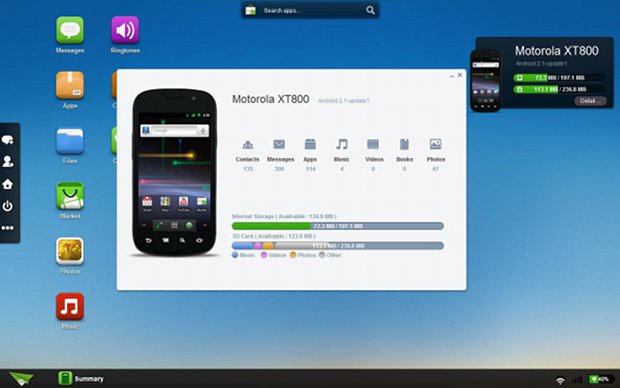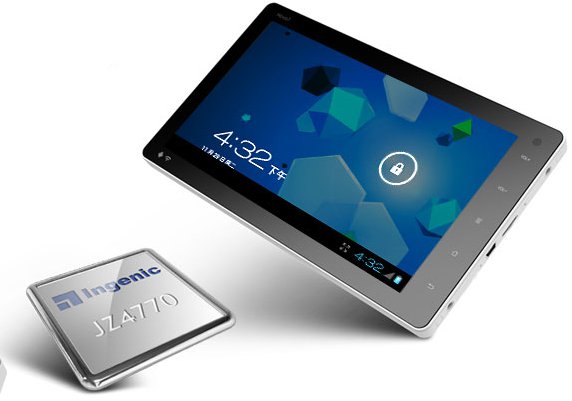Qualcomm has just announced the availability of QCAR SDK version 1.5 Beta 1 for Android. is now available for download. The Key features and improvements in this version of the QCAR SDK include: Video background texture access: The SDK now provides a simple and streamlined way of accessing the video background texture. Developers can now write custom special effects using powerful shaders resulting in far more exciting application experiences. Swapping datasets at runtime: If your app needs to augment more than 60 images, you can now create multiple datasets – using the web-based Target Management System (My Trackables tool)- and load the appropriate dataset at runtime. You no longer have to upgrade your app to change the target dataset, and you can now build AR experiences that work on a large number of images. Improved tracking performance: The new SDK features several enhancements that reduce jitter in the augmentations, speed […]
Use Your Desktop Computer to Control Your Android Device
AirDroid is a free application that allow you to control your Android smartphone (or tablet) with your computer via WiFi. You simply need to install the app on your smartphone and to connect to the interface with your desktop web browser. You’ll then be able to manage your files, pictures, contacts.. or send SMS with your computer keyboard. You can watch the video below for an overview of AirDroid features: You can download this application at http://market.android.com/details?id=com.sand.airdroid Jean-Luc Aufranc (CNXSoft)Jean-Luc started CNX Software in 2010 as a part-time endeavor, before quitting his job as a software engineering manager, and starting to write daily news, and reviews full time later in 2011. www.cnx-software.com
Nokia Developer Day 2: Qt QML Workshop – Chiang Mai
I’ve just attended Nokia Developer Day on 6-7 December 2011 in Chiang Mai. I’ve already written a summary about the first day dealing with Series 40 Java and Web Apps Workshop. The second day was focused on Qt/QML (Qt Meta-Language) software development for Nokia’s Symbian phones. Nokia will phase out Symbian operating system in 2016, but they’ll still support it until that time. Nokia will also port Qt to lower end phones (e.g. Series 40) on a new operating system based on Linux called Meltemi. Overall Business Direction & Strategy The first 45-minutes for was presentation given by Grant Aaron McBeath, Managing Director, Nokia Thailand and Emerging Asia, about Nokia business direction: focus on Windows Phone for smartphones, Java/Web Apps for feature phones and future disruption. He also showed the progress of Nokia Ovi Store with 10 million downloads a day and 177 publishers with more than 1 million downloads. […]
Android 4.0 on Archos G9
Archos has been working on porting Android 4.0 (ICS) to Archos G9 Series Android Tablet (Archos 80 G9 and 101 G9) and have released a video demo (via Charbax). Archos G9 tablets are powered by OMAP4430 and OMAP4460 (Turbo version) so the port should have been pretty smooth as it is the default SoC used by Android 4.0. Archos still have to complete video hardware acceleration, Samba/Upnp and 3G stick support as well as all other Archos-specific features. The offical Android 4.0 release for Archos G9 should be available by Q1 2012. Jean-Luc Aufranc (CNXSoft)Jean-Luc started CNX Software in 2010 as a part-time endeavor, before quitting his job as a software engineering manager, and starting to write daily news, and reviews full time later in 2011. www.cnx-software.com
Nokia Developer Day 1 Summary – Chiang Mai
I’ve just attended the first day of Nokia Developer Day (6-7 December 2011). The focus was on software development for Nokia’s feature phones with Java or Web Apps (HTML/CSS/Javascript) and most of the time was spent on workshops to get started for developing for Nokia feature phones such as the S40 series. Introduction to Ecosystem Business Updates During the first 15 minutes, an “Introduction to Ecosystem Business Updates” was given by Jirapat Janjerdask, Head of the Ecosystem Developer Experience at Nokia Thailand. He gave an overview of the ecosystem for features phones including the brand, developer & publisher, mobile brand, mobile operator and consumer. One interesting statistics was that there are 10 millions app downloads every single day. He also talked about the new Nokia Asha 300 and 303 features phones available for 3000 to 4000 Thai Baht (100 to 130 USD) that are capable of running applications that usually […]
99 USD Android 4.0 Tablet (Novo 7) Powered By MIPS Processor
MIPS has just announced the Novo 7 a low cost Android ICS tablet powered by Ingenic’s JZ4770 mobile applications processor that leverages a MIPS-BasedTM XBurstTM CPU running at 1GHz. The new tablet is available with a 7″ capacitive multi-touch screen. 8″ (Novo 8 ) and 9″ (Novo 9) form factors will be available soon. All versions include support for WiFi 802.11 b/g/n, USB 2.0, HDMI 1.3 and microSD, as well as 3D graphics with the Vivante GC860 GPU, 1080p video decoding and dual front/rear cameras (2 MPixel). The XBurst processor’s power-efficient architecture provides extended battery life-the 7″ tablet draws less than 400mA during active web browsing. The Ingenic JZ4770 SoC inside of this (ultra) low cost tablet is one of the first MIPS-based systems-on-chips (SoCs) targeted for mobile devices that delivers 1GHz+ frequency. The JZ4770 SoC is powered by a MIPS32 compatible XBurst CPU designed by Ingenic. The XBurst CPU […]
Ronetix announces Five New Atmel SAM9 CPU Modules
Ronetix announced 5 CPU modules based on Atmel AT91SAM9 series: SAM9G35-CM – populated with AT91SAM9G35 SAM9G25-CM – populated with AT91SAM9G25 SAM9G15-CM – populated with AT91SAM9G15 SAM9X35-CM – populated with AT91SAM9X35 SAM9X25-CM – populated with AT91SAM9X25 Those 5 mew modules correspond to the 5 New Atmel processors and Devkit announced in August 2011. All modules offer 400MHz performance, 128MB to 256MB DDR2 SDRAM, 256MB NAND flash and 4MB to 8MB SPI flash. Here’s a comparison table of the different features available on the 5 modules / processors. Features SAM9G15 SAM9G35 SAM9X35 SAM9G25 SAM9X25 EMAC – RMII RMII MII MII + RMII ADC channels 12 12 12 7 7 CAN – – y – y 5-wires touchscreen y y y – – LCD y y y – – ISI – – – y – additional USART3 – – – y y The modules support the operating supported by SAM9 processors namely Android, […]
Try Windows Phone 7.5 on Your Android / iOS device or Desktop
If you own an Android smartphone or iPhone, and wonder what Microsoft Windows Mobile 7.5 looks like, you can now try it directly inside your phone without installing anything. Microsoft has setup a HTML5 website which offers a working demo of Windows Phone 7.5. It’s obviously not the same as the full OS, but it does allow visitors to experience the look and feeling of Window Phone 7.5 and access applications such as email and calendar. Simply visit http://aka.ms/wpdemo in your mobile phone browser to try the demo. If you don’t own a smartphone yet, you can also try it in your desktop browser. It did not work in Firefox for me, but works fine in Chrome. You can tap to access different menus. Once you are inside a menu, you’ll be asked to swipe or tap to discover the features of the operating systems. All demos are pre-recorded, so […]








